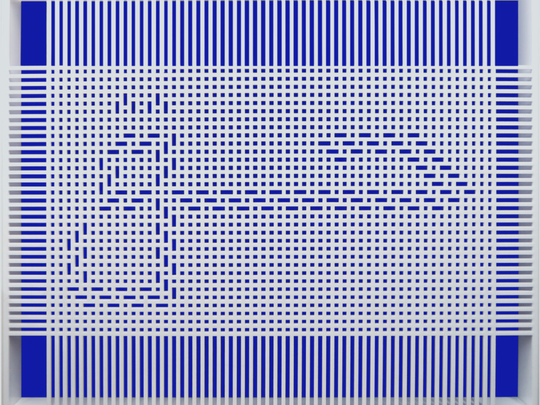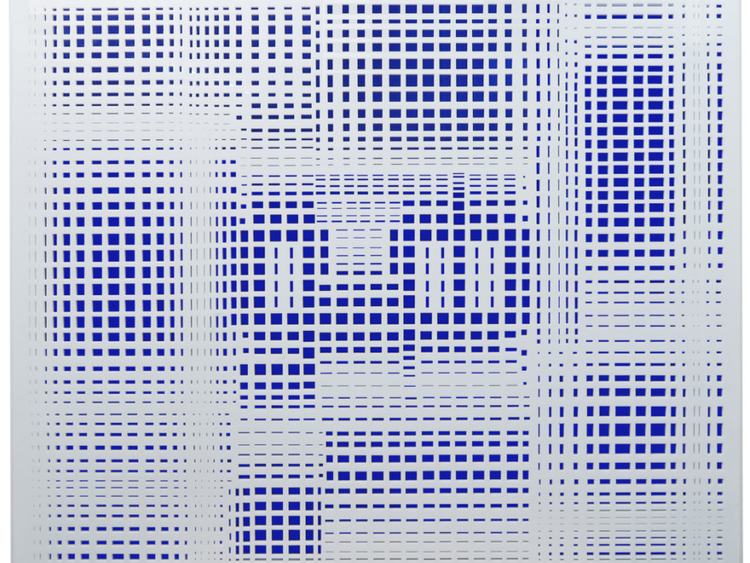
Saudi Arabian artist Lulwah Al Homoud is interested in exploring the complexities of linguistic, mathematical and visual systems of communication. Based on her research of the systems used in Islamic art and calligraphy, she has developed her own visual language with which she communicates with her inner self and with the world. The artist who lives between Dubai and London is presenting her meditative abstract multi-media artworks in a show titled, Beyond the Grid.
Al Homoud is fascinated with the geometric intricacies of calligraphy and trained under renowned Pakistani calligrapher Rasheed Butt. She did her MA in London at Central Saint Martin’s College of Art and Design in Communication Design with a focus on Islamic Art.
“I wanted to learn the rules, systems, ratios and proportions of Islamic calligraphy and geometric art so that I could go beyond that grid and develop something new. For my post-graduate thesis, I did research on the Vedic Square, a multiplication system based on a 9x9 grid developed in north India and its modifications used in Islamic art and calligraphy; the proportional writing system of Ibn Muqla, which is based on a circle with the diameter of the letter Alif; and other mathematical systems used for defining calligraphic scripts and generating infinite geometric patterns. I then deconstructed these systems, scripts and patterns and devised my own systems to create a new coded language where pattern and word are fused into one visual symbol,” the artist says.
Over the last 10 years Al Homoud has been working on an ongoing series where she uses this abstract language to create digital compositions portraying the 99 names of God. In each work, she has arranged the letters of her script not only to form the name, but also to convey its meaning visually. The series, titled The Language of Existence, currently portrays 50 names of God. Even though the names written in her coded script cannot be read, her abstract compositions convey an inherent energy and sense of spirituality. The artist is presenting these works in the show as a set of 50 silk-screen prints on paper, limited edition bound books, and illuminated hand painted works mounted in light boxes.
Our place in the universe
“I have used a blend of Eastern and Western mathematics, but I went beyond the grids in these traditional systems. In my system I used numbers that represent the first nine stages of cell multiplication in the creation of human beings to link us with our creator. I call this series The Language of Existence because it is about expressing my faith and my belief in the existence of God. It is about thinking deeply about our place in the universe and how we connect with our creator and all of creation. It reflects on the dualities of the human condition and attempts to link the finite with the infinite, multiplicity with unity and transience with eternity. Everything in nature and the universe is based on some mathematical system and coded language. I want my viewers to stop and think about this and to delve deep into the rhythms and intricate systems of the cosmos and reflect on their relationship with God,” Al Homoud says.
The artist is also presenting new works that are inspired by contemporary optical art. In some works, she has used laser cutting to create grids of vertical and horizontal lines on a wooden panel mounted on acrylic. Parts of the grid are distorted to form pixelated words representing the names of God. In other works, she has painted the names inside a circular grid on black linen with gold leaf to represent the divine light. The monochromatic works have a spiritual feel, inviting viewers to look beyond the grid and contemplate the depth and meaning of the names.
“As we engage in the dichotomies of existence, the rhetoric between substance, essence and fate compels us into asking what is abstract, what is solid, what is common and what is particular. This discourse moves back and forth between the humanities and the sciences, constantly shedding and reconstructing subtle layers.
“Arguably, what is most incongruous in this discourse is what is most convergent within it — and that is communication. Using a pure language, my work locks together geometry, faith and beauty, pushing the boundaries of what we know, how we know it and how it is perceived,” Al Homoud says.
Jyoti Kalsi is an arts-enthusiast based in Dubai.
Beyond the Grid will run at Tabari Artspace in DIFC, Dubai, until June 28.













